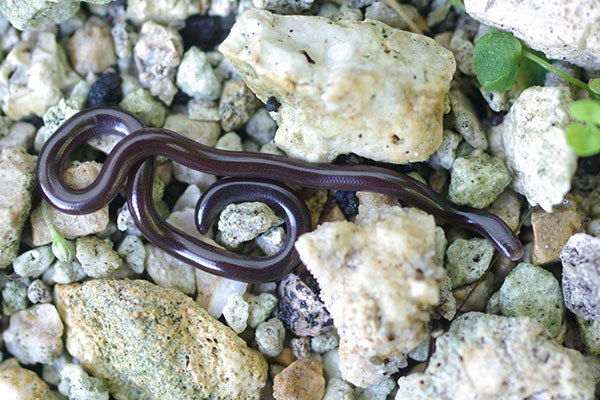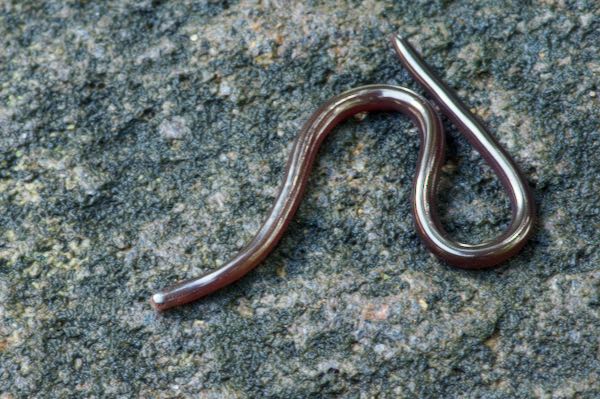Indotyphlops braminus
—
Brahminy Blindsnake
Also known as:
Brahminy Blind Snake, Flowerpot Snake
This species was classified as Ramphotyphlops braminus until a restructuring of blindsnake taxonomy in 2014.

These tiny snakes look like dark shiny earthworms. This Southeast Asian species has successfully colonized south Florida and many other subtropical and tropical regions as a stowaway in the soil of nursery plants. They are fantastic colonizers, due in large part to the fact that they are perhaps the world's only entirely parthenogenetic snake species. That is, they are all females, and reproduce asexually, so it only takes one to start a colony.
I had seen these on a few occasions over the years in South Florida but I had never managed to detain one long enough to get a picture; they are extremely squirmy and excellent at escaping, despite their tiny size. Once my wife and I found five or six of them crawling around inside my mother in law's home. We chose not to tell her that her house was infested with snakes.

Some day I'll try to get an actual good photo of these reflective, squirmy, tiny snakes. But at least this one is a little better than the last one.

Thirteen years later I finally got another opportunity to try to get a good picture of this species. But this one was just as reflective and squirmy as its clones in Florida.

This is the saddest photo of my trip. Before our evening hike, I was poking around behind my bungalow to see if there was anything worth photographing. I saw this cricket and took a photo of it when I noticed what I thought was a long thin millipede. So I took a photo of that, but since it was only a no doubt unidentifiable millipede I didn't try to get a nicer photo. Only when I looked at the photo later did I realize it was a blind snake, not a millipede. So I didn't get a better photo, but worse, I didn't show it to my fellow herpers, some of whom had never seen a blind snake. I hung my head in shame.
These snakes have been accidentally introduced to Madagascar, along with most of the rest of the tropics.
Here is a list of all the reptiles and frogs I saw on this 2023 trip to Madagascar.
Online references:
- Indotyphlops braminus account on The Reptile Database
- Alexander Pyron, Robert & Wallach, Van. (2014). Systematics of the blindsnakes (Serpentes: Scolecophidia: Typhlopoidea) based on molecular and morphological evidence
Printed references:
- Ashton, R. E. Jr., Ashton, P. S. 1991. Handbook of Reptiles and Amphibians of Florida, Part Two: Lizards, Turtles, & Crocodilians, Revised Second Edition
- Carmichael, P., Williams, W. 1991. Florida's Fabulous Reptiles & Amphibians
- Conant, R., Collins, J. T. 1998. Peterson Field Guide to Reptiles and Amphibians of Eastern and Central North America, Third Edition, expanded
- Crother, B. I. (ed.) 2017. Scientific and Standard English Names of Amphibians and Reptiles of North America North of Mexico, with Comments Regarding Confidence in Our Understanding, Eighth Edition
- Glaw, F., Vences, M. 2007. A Field Guide to the Amphibians and Reptiles of Madagascar, Third Edition
- Tennant, A. 1997. A Field Guide to Snakes of Florida
- de Silva, A., Ukuwela, K. 2017. A Naturalist's Guide to the Reptiles of Sri Lanka